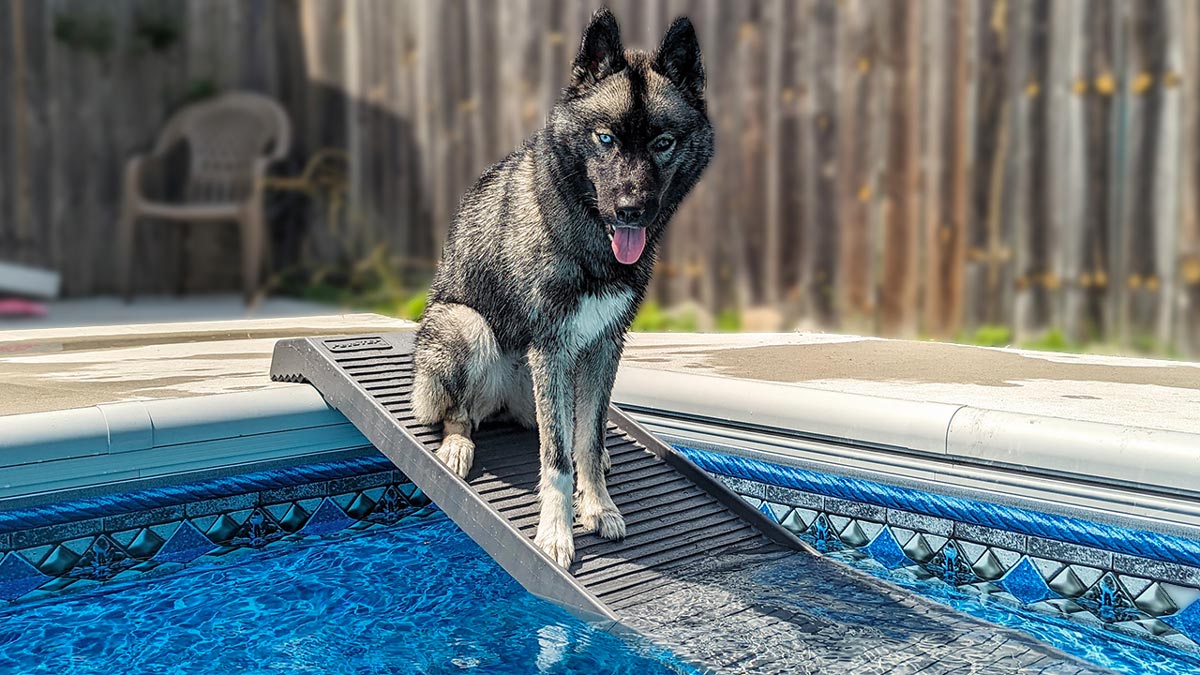-
- SHOP
- Pool Ramp for Dogs
- For People
- For Pets
- Gallery
- Blog
- Our Company
- Cart
- Login
- Newsletter
- Free US Shipping on orders over $79!
As a dog owner, you know there’s nothing better than seeing your dog full of joy. You’d do anything to keep your dog’s tails wagging. So if your dog loves to swim, and you have a pool, you want to help them enjoy the water as much as possible. Because pool designs, both above-ground and below-ground, vary, it’s very likely that your dog is not able to get in and out of your pool safely. While they may be able to jump into the pool, they may not be able to get themselves out because pool ladders and steep steps are not made for paws.
Many dog owners with water-loving pups have provided their furry companions with a dog ramp to get in and out of the pool safely. When searching around for one, you may run into some DIY ideas on the likes of Pinterest or other social media channels. While do-it-yourself projects can be fun (for craft lovers) and sometimes cost-effective, building a dog ramp for your pool is a venture that demands careful consideration.
In this blog, we’ll explore the potential risks and challenges associated with DIY dog ramps for pools, emphasizing why safety should always take precedence.
While the term “do-it-yourself” or “DIY” implies that the task is straightforward enough that anyone can do it at home, building a sound and safe structure for your dog to use in the pool is no small feat. There are many things you should consider during the designing and building process for a dog pool ramp.
Before the construction can even begin, you’ll need to figure out the design of the ramp. You may want to design your own ramp or emulate one you’ve seen on Pinterest or somewhere else on the web. The drawback to this is that you really have no idea if the particular ramp design you’re going for will work, and there will likely be a lot of trial and error. Things like the angle and inclination of a dog ramp are critical factors that affect its usability and safety. You’ll need to take a lot of measurements and brush up on your math skills to make sure your DIY ramp can be usable by your dog. An improperly constructed DIY ramp might have a steep angle, making it difficult for your dog to use. Furthermore, if the ramp doesn’t have a secure grip on the pool edge, and can slip around or even fall into the pool. This could discourage your pup from using the ramp or even result in accidents or injury during ascent or descent.

When looking for dog pool ramp inspiration online, the most popular materials used are either wood or a combination of anti-fatigue mats and pool noodles. The wood ramps extend down to the pool floor at an angle while the pool noodles keep the anti-fatigue mats somewhat afloat for your dog to grab onto. While each of these designs may seem like it will make it easier for your dog to use the pool, as you read on, you’ll discover that the material and construction may not be the safest and most effective solution for your dog.
The durability and safety of your dog’s pool ramp are contingent on the choice and quality of the materials used to construct the ramp. A complication with constructing your own pool ramp is not knowing whether the materials will have sufficient structural integrity. Insufficient materials or improper assembly could lead to a ramp that collapses under the weight of your dog, potentially causing injury.

For wood ramps, purchasing the needed wood and other materials, like sealant and perhaps a saw, for construction can get pricey. Because the wood will be exposed to water for long periods of time it will need to be sealed with some sort of wood preservative to prevent degradation, which adds to the cost and time it takes to complete the ramp. Constructing a wood ramp will also take a bit of skill and you’ll likely need to be well-versed in using saws and power drills.
Ramps constructed of anti-fatigue mats and pool noodles zip-tied together will likely be easier to assemble compared to a wood ramp. While the pool noodles and mats won’t degrade in the pool, it is unclear whether these materials are durable enough to be consistently used by dogs enjoying the pool. The mats and pool noodles can easily rip or become unattached, potentially causing stress or injury to your pup. Because the construction is lightweight and buoyant, it’ll need to be securely attached to the pool’s edge, which can add additional costs and complications.
Beyond the potential risks that come with the materials used to construct the DIY dog ramp, there are additional safety concerns that must be considered. Something that may be overlooked is the need for a non-slip surface given that the ramp will be submerged. While rubber floor mats will have a bit of grip to them, wood DIY ramps can be extremely slippery and may even risk putting splinters in your pup’s paw. Without a non-slip surface, the DIY dog ramp will not be able to provide your dog with secure footing, potentially causing slips and falls when entering or exiting the pool.

Different dog breeds vary in size, weight, and strength. A DIY ramp might not be engineered to safely support your specific dog’s weight or activity level, leading to potential accidents. Professionally designed dog ramps are rigorously tested to ensure they can handle the load, offering peace of mind that your pup is safe. If the ramp fails while your dog is using it, it could leave them stranded in the pool which can not only cause injury from your dog trying to haul themselves up the side of the pool, but it can also cause extreme stress that could ruin future pool enjoyment.
Certain dog breeds, especially as they age, are prone to joint and mobility issues. Because swimming is such a great exercise for dogs with arthritis, hip dysplasia, and other joint issues, many dog owners want to make the pool safely accessible for this aquatic therapy. DIY dog ramps, however, usually do not have a gentle enough incline to comfortably accommodate dogs with mobility issues. A harsh incline or failing DIY dog ramp can further exacerbate your pup’s joint or mobility issues.
While DIYing a dog ramp might seem like an easy way to make your pool more accessible for your pup, it’s best to leave it to the pet professionals when it comes to the safety of your dog. The PetStep Pool Ramp for Dogs, for example, was designed by a team of engineers to ensure the safest and most comfortable usability.
Perfecting the angle of the pool legs and ramp was of utmost importance to our engineering team. When the pool legs are attached to the PetStep pool ramp, they create a gentle slope in and out of the pool. This makes it ideal for both large and small dogs, as well as dogs that suffer from any joint or mobility issues. Because pool depths vary, we’ve designed a standard and long set of pool legs to accommodate just about any pool depth where the ramp will be installed.
While it’s difficult to DIY an effective non-slip surface, the PetStep ramp features an exclusive rubberized ridged surface that lets your pup dig into the surface while walking. Even when totally submerged, the surface creates unbeatable traction so your dog can safely walk in and out of the pool without the risk of a slip or fall.
One of the issues with DIY dog ramps for pools is how they will be attached to the pool edge or deck without slipping. The PetStep ramp features a non-slip rubber grip on the bottom edge of the ramp to keep the ramp stable on the edge of the pool. The ramp is constructed from hard-wearing plastic and fiberglass so it will never degrade in the pool water like a DIY wood ramp would.
The PetStep pool ramp was designed to make pool fun possible for every pup! With two pool leg length options, it can be used in pool depths from 42-62 inches. The splayed leg design prevents side-to-side wobbling so even the most active of pups will be able to use the ramp.

While the idea of creating a DIY dog ramp for your pool may seem appealing, it’s important to recognize the potential risks and safety concerns that accompany such a project. Your dog’s well-being should always be the top priority, and investing in a professionally manufactured dog ramp like the PetStep ramp ensures that your furry companion can access the pool safely and comfortably. The PetStep pool ramp is designed with your dog’s well-being in mind so you can safely make memories together in the pool. When it comes to your furry friend’s enjoyment and safety, it’s best to leave the design and construction of a dog ramp to the experts.